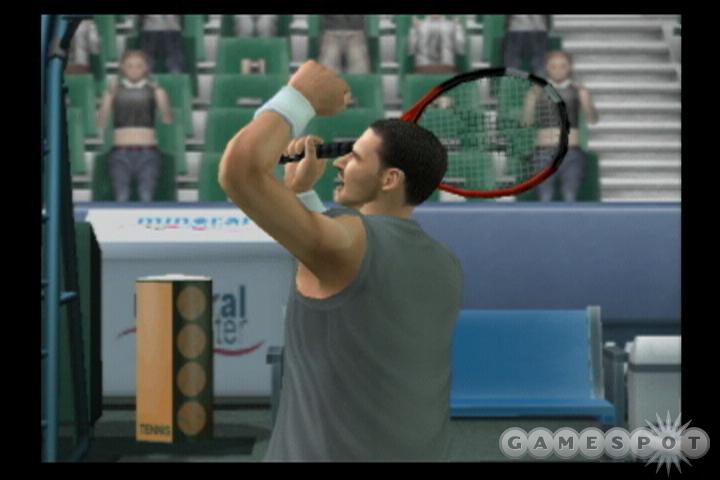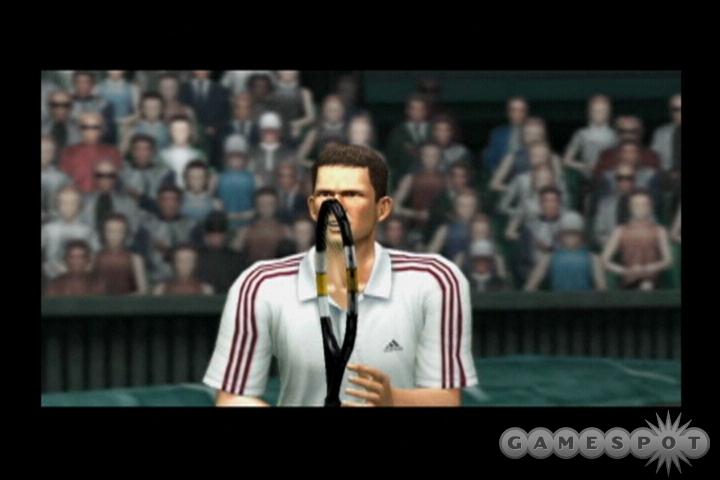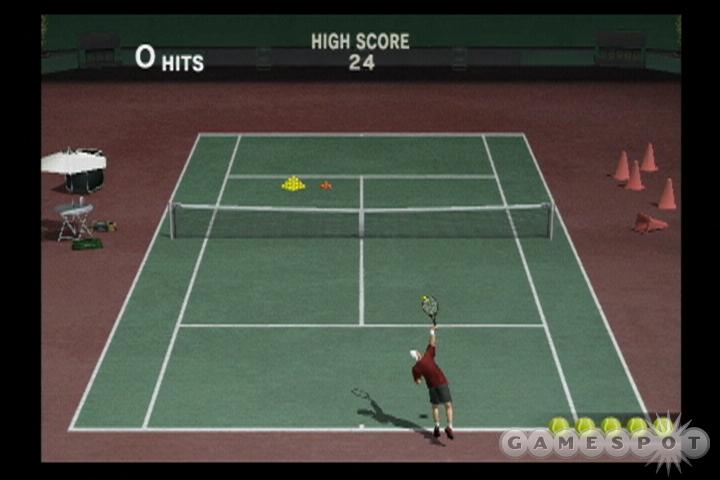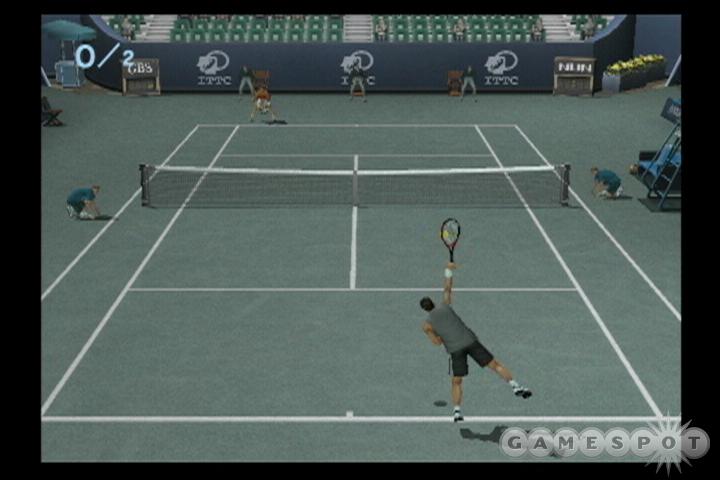It's rather hard to discuss modern tennis video games without bringing up Sega's genre-defining Virtua Tennis. The original Smash Court Tennis Pro Tournament took nearly all of its cues from Virtua Tennis, and though that influence is still apparent in Smash Court Tennis Pro Tournament 2, the series has started to develop an identity of its own, most noticeably in regard to its core gameplay. This is a more focused, precision-based tennis game than any of the Sega-published tennis games ever were, so PlayStation 2 owners who have just grown weary of Sega Sports Tennis--and are up for the challenge--should find plenty to like about Smash Court Tennis Pro Tournament 2.

Like its predecessor, Smash Court Tennis Pro Tournament 2 is a straightforward tennis game that takes the game pretty seriously. You won't see primary-colored mascots, supercombo shots, or crazy court locales. Instead you'll have a roster of 16 real-life pros to choose from, which represents double the number of pros in the first Smash Court Tennis Pro Tournament. This roster includes the most prominent players in the game right now, including Andy Roddick, Tim Henman, Lleyton Hewitt, Serena Williams, Justine Henin-Hardenne, and Kim Clijsters. The game also boasts more than 10 different courts, including the four tournament locations that constitute the Grand Slam Tournament series--the Australian Open, Roland Garros (aka the French Open), Wimbledon, and the US Open.
These are the stars and the courts that you'll be spending your time with and on, respectively, in the arcade and exhibition modes. The arcade mode puts you through a series of three to five tournaments against some challenging artificially intelligent opponents, while the exhibition mode grants more customization options, letting one to four players choose the pros they'll play as and against as well as the courts they'll play on. Players also get to determine whether they'll play singles or doubles exhibition matches.

The pro tour mode takes the spotlight off the established stars and lets you create your own rising star in the world of tennis. Most of the physical customization options here are pretty by-the-book, though the fact that you're asked to choose from a short list of animations for both serving and receiving stances caught our eye as nice touches. Statistic customizations seem even more comprehensive, since your pro's abilities are broken into five specific categories, some of which are then broken into several subcategories. Once you've defined your character, you'll start playing through a week-by-week season of tennis, which includes plenty of tournaments and lots and lots of training exercises--especially at the beginning, when your world ranking isn't high enough to qualify for most of the tournaments. Successfully completing training exercises and winning tournaments will net you experience points, which you can use to increase any of your pro's discrete stat fields. It takes a little while to really build up some momentum in the pro tour mode, so you'll have to spend awhile slogging through the same three training exercises over and over again until your pro is capable enough to start winning tournaments, gain ranks, and qualify for a wider range of tournaments. As you progress, you'll also earn points that can be used in the game's pro shop, where you can purchase a variety of gear that serves aesthetic and performance-enhancing purposes.
One of the more interesting things about the pro tour mode is the way that tournaments are handled by default. Rather than have you play the eight or more matches you'd need to win a tournament, the game simulates the majority of the action, and you only play a handful of decisive games, which come with extra mission objectives, such as serving aces, serving the ball right on the service line, or executing a certain percentage of high-quality shots. This option definitely speeds up the tournaments, which have classically had a tendency to become rather monotonous. For the players who would prefer a greater level of personal control over these tournaments, an option exists that lets you play all the games yourself. There are some other nice, little touches, like the occasional piece of fan mail you'll receive or an invite to a special tournament, but the fundamentals of the pro tour are all pretty familiar, and the mode doesn't have quite the depth we've seen in the career modes in other modern tennis games.
The game also features a challenge mode, which, for the most part, just takes the training exercises you'll go through in the pro tour mode and puts them out on their own. Probably the most useless mode in the game is the spectator mode, which lets you choose the pros and the court, and then the AI takes over and simulates a series of matches. It's something that you'll probably mess with once or twice, but if there's any appeal beyond that, it's pretty limited.

By contrast, the most valuable mode, at least for Smash Court first-timers, is the tutorial mode. This is doubly true for players who have been weaned on the Virtua Tennis style of gameplay, which is a lot more arcade-influenced, and, as such, is a lot more forgiving. The movement controls are similar, though the players are less prone to Hail Mary swan dives for just-out-of-reach shots, but the shot mechanics are like an inverted version of the standard Virtua Tennis mechanics. The face buttons on the controller give you instant access to slice, top spin, flat, lob, and drop shots, and you can still influence the direction of your shot by moving the left analog stick just before taking your shot. But rather than holding down the button to charge up the power of your shot, you'll have to time your button press at just the right time as the ball approaches you to get the most power from your swing. Of course, it'll take some practice to get the timing down just right. The overall feel of the gameplay is a lot tighter than the first Smash Court Tennis Pro Tournament (which plays a big part in giving Smash Court Tennis Pro Tournament 2 its own unique feel), and the way some of the mechanics are handled makes the interface seem more transparent. But does all this make the action any more satisfying? Not especially. It does, however, make the learning curve steeper, though not insurmountably so.
It's been almost two years since there's been a tennis game worth mentioning for the PlayStation 2, and so, without pushing terribly hard, Smash Court Tennis Pro Tournament 2 comes away as the best-looking tennis game to grace the platform. The character models feature some great texture details, and they animate quite naturally, though you'll notice certain transitions can be a little rough. Furthermore, there are some nice, subtle variations between the animations for the different players. The court surfaces look quite real and will show some subtle wear over the course of a match. The lighting system that's in place isn't particularly complex, but the shadows cast by the players and the ball look clean and sharp, which really pretty well describes the game's overall look. There are some points of the presentation that would have benefitted from a little more polish, such as the area just outside the court. You never get much of a sense of the size of the arenas, and whenever the camera cuts to the crowd in between rounds, you'll notice some really ugly and poorly animated 2D sprites filling the bleachers. The game is also pretty light on the flashy special effects, opting instead for a true-to-life presentation, which can either come across as dry or authentic depending largely on how realistic you like your tennis games.

The visual design has a real cohesive feel to it, which isn't as true for the game's sound. The in-game effects include a suitable collection of racquet smacks, the occasional grunt, and some basic crowd noises, the last of which seem to loop a bit too much. The English-accented announcer gives the game a slight air of propriety, which is undermined by a cheesy, light pop instrumental soundtrack. The trend of kitschy soundtracks in tennis games was kind of charming when Virtua Tennis first came out, but quite frankly, it's just tired now. This game would have been better off with legitimately well-produced music, or, failing that, nothing at all.
Though the game largely comprises the same pieces that we've encountered in other tennis games, Smash Court Tennis Pro Tournament 2 still helps establish the series as more than just a Virtua Tennis clone, even if just marginally so. Though a lot of players will find the less-forgiving-gameplay style of the game to be a bit of a turnoff, this is still a solid game of tennis, and it's the best one to have appeared on the PlayStation 2 in years.